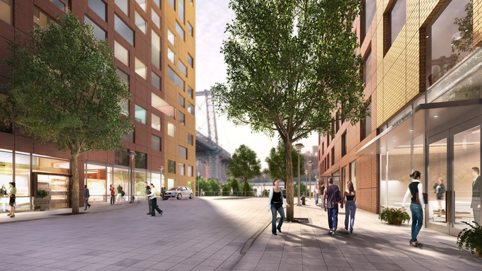Final Deal on New Domino Locks in Parking, Adds Shuttle Buses
 Add a whole lot more cars and some shuttle buses to this picture, and you’ve got the approved plan for the New Domino. Image: The New Domino
Add a whole lot more cars and some shuttle buses to this picture, and you’ve got the approved plan for the New Domino. Image: The New DominoThe New Domino development slated for the Williamsburg waterfront passed the City Council’s land use committee yesterday in a unanimous vote, thanks to a last-minute deal between the developer and project critics. Under that agreement, the project’s tallest towers will shrink from 40 stories to 34, though the total number of units will remain the same. The project is now expected to sail through the remainder of the approval process.
In terms of transportation, the developer has now promised to provide shuttle buses to nearby subway stations. With room for 1,428 cars, the project is far from a model of sustainable planning, but with the fight over New Domino now at a close, it’s worth remembering that livable streets advocates won some real improvements during the land use review process: the shuttle buses and last month’s reduction in off-street parking.
The bottom line remains, however, that with 1,428 parking spaces, this is an auto-oriented development. "The transportation plan hinges on bringing more cars into the neighborhood," said Ryan Kuonen, an organizer with Neighbors Allied for Good Growth, a local community organization. Still, she said, "It could have been worse — the plan used to be worse."
With both Mayor Michael Bloomberg and City Council Speaker Christine Quinn strongly supporting the project, final approval was all but guaranteed. "This thing was going to get passed," said Kuonen. The only question was how the New Domino would change on the way to approval, and the adjustments that unfolded were almost uniformly towards more livable streets.
The changes were "pretty much as good as you were going to get on these issues," said Rachel Weinberger, a parking expert and professor of transportation planning at UPenn. "If this is what we get when the system is working how it’s supposed to, we need to rethink the system."
The shuttle buses, if implemented well, could help make transit the mode of choice for a few more New Domino residents — and will certainly improve their trips. The project is located about three-quarters of a mile from the closest subway stations. That’s walkable, but hardly appealing in miserable weather. A shuttle will give the significant number of people who’ll be taking the subway a quicker, more pleasant commute. "It’s the right idea," said Weinberger, noting that the implementation will matter a lot. According to Council Member Stephen Levin’s office, the routes haven’t been determined yet.
The inclusion of shuttle buses at the New Domino also sets an important precedent. "It expands the envelope of what types of transportation improvements developers are responsible for," said David King, a planning professor at Columbia who had previously called for including shuttle buses at Domino. "In most cases developers are only responsible for parking," he continued, explaining that buses are very rarely a condition for approval. If it becomes widespread practice to require large-scale developments to improve residents’ access to transit, not just give them space for cars, that’s a tangible shift.
Shuttle buses can only do so much, however. First, they’ll be targeted only at New Domino residents. "It’s really solving a problem for the people moving there," said Kuonen, "not the people who are already living there." One easy way to ensure that these shuttles are a community benefit, not just a resident perk, might be to run them all the way to Union Square; many Williamsburg residents were more concerned about adding even more commuters to the overstuffed L train than they were about added congestion on the roads.
More importantly, shuttle buses will do little to counter the car use induced by all that parking. "They will serve the people who don’t have a parking space," said Weinberger. "It’s not going to be of huge relevance to those who have a car," she continued, citing research she just completed showing that in New York City, residents with parking are likely to drive to work, even if they live near good transit options. The congestion-busting impact of the shuttle buses, therefore, will be limited.
So about all that parking. Here too, livable streets activists won a small victory. Local organizing convinced Borough President Marty Markowitz to request a 266-space reduction in the amount of parking at New Domino, which the City Planning Commission agreed to enact — a rare case of the review process yielding a less car-centric outcome than the initial proposal.
Of course, the amount of parking originally proposed was so enormous that the New Domino will still add a flood of cars to the neighborhood, congesting the free Williamsburg Bridge just feet away, guzzling gas and exposing pedestrians and cyclists to greater danger. The policy that larded Domino with parking in the first place — attempting to build enough off-street automobile storage to match the car-ownership rates of the surrounding area — needs to be discarded as too disconnected from broad transportation goals.
Moreover, while the shuttle buses could quite easily disappear after a few years, these parking spaces are forever. That’s why it rankled when the mayor promised a comprehensive traffic and transit study for the area as one piece of yesterday’s deal. The city has already made a huge, and permanent, transportation decision. If, years from now, that comprehensive study finds that the inclusion of so much parking was a bad decision for the neighborhood, the horse is already out of the barn. The only way to align this project with the goals of PlaNYC, significantly reducing the amount of parking, won’t be an option.





